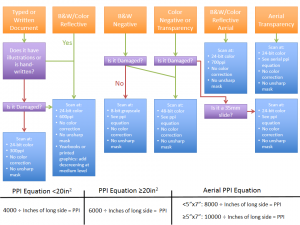Digitization
For digitizing cultural heritages materials we follow the Federal Agencies Digitization Guidelines Initiative’s documentation. We designed a convenient flowchart for student scan technicians to reference in the lab when determining digitization settings for various material types. The equipment we use to digitize documents can be found here.
Metadata
Our metadata is based mostly on Dublin Core and qualified Dublin Core, and we follow the South Carolina Digital Library’s metadata guidelines. By using SCDL guidelines, we are also following the Digital Public Library of America’s guidelines.
Metadata is tracked consistently throughout a project’s life, which can be indefinitely. You can download a copy of our metadata production spreadsheet here. Scan technicians are required to record all metadata they encounter when scanning an object. This includes anything written on the back of an image, labels on folders, notes attached to an object, and transcribing a catalog card affiliated with an object. This metadata is kept to production-level fields in the spreadsheet so metadata specialists or catalogers can derive and create properly formatted metadata in the metadata profile fields further along in the spreadsheet.
Copyright
We use these useful tools for determining copyright status of documents:
- Cornell: Copyright Term and the Public Domain in the United States (January 1, 2012)
- Stanford has an entire page devoted to charts and tools
Handling of Materials
All materials must be handled with care
Much of the damage that books and archives sustain is due to poor handling. As a partner with cultural heritage institutions and archives across the state, we have a responsibility to ensure the best possible care of the materials in the collections we are working with. All student scan technicians are trained by Special Collections in the handling of materials.
Retrieving materials for digitization
- Follow the instructions of the archivists in Special Collections.
- Hands must be “clean” before handling items in any collection.
- “Clean” means to wash and dry hands thoroughly. Do not use lotion or hand creams after washing.
- Some materials should be handled -only- with cotton gloves. This includes: negatives and photographs. Do not use cotton gloves for handling books, paper, or glass plate negatives.
- Some materials should be handled -only- with nitrile gloves. This includes: glass plate negatives.
- Collection items should be supported at all times (e.g. if a rare book is opened, its covers must be supported from beneath, using a cradle or blocks).
- Collection items should always be removed one at a time
- Use two hands to carry large volumes or boxes.
Safeguard the integrity of archival documents by maintaining their original order
- Use only one folder from a box at a time.
- “Maintain the existing order of material” within each folder and box
- Put all materials away correctly.
Do not
- Wear jewelry or watches while scanning.
- Keep any beverages or food in your work area when handling original materials.
- Make any marks on material or erase existing marks
- Write, lean or rest on top of materials.
- Use fountain pens, felt tipped pens, or similar writing instruments alongside materials
- Touch the text or image on the page. Handle all materials by their edges when possible.
- Fold, tear or cut documents
- Make tracings of any documents
- Rest any other objects on the surface of any items
- Apply paper clips, fasteners, tape, Post-it notes or rubber bands
- Stack books more than three high.
- Place items on the floor.
- Use hand lotions before handling materials.
- Allow books or pamphlets dangle off scanners. Collection items should be supported at all times.
